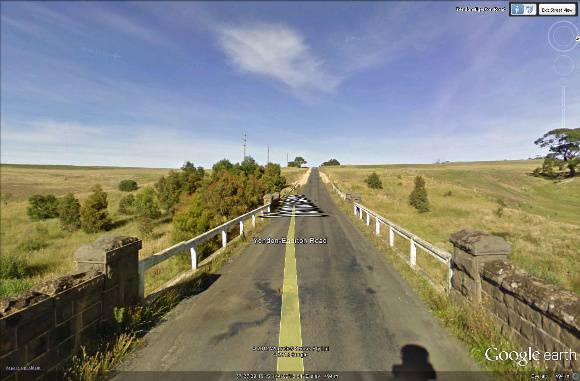| Back to search results » | Back to search page » |
|
Blue Bridge over Moorabool River East Branch
LocationYendon/Egerton Road,, LAL LAL VIC 3352 - Property No B7213
File NumberB7213LevelState |
|
Statement of Significance
What is significant? The Blue Bridge is an unusual bridge combining nineteenth century bluestone abutments and rail deck and concrete superstructure in an isolated and picturesque setting. The bridge comprises bluestone abutments and a central bluestone pier originally constructed in the mid nineteenth century as part of the laminated timber arch bridge. The timber super structure was replaced in the early twentieth century with a form of steel rail deck bridge constructed using second hand worn lengths of rail with concrete cast in place to form the deck. Blue Bridge is on a former gold route, which served Mt. Egerton and Buninyong, the latter the site of one of the earliest finds of gold in Victoria.
How is it significant? The Blue Bridge is significant for aesthetic/architectural, historic, and technical reasons at a State level.
Why is it significant? The Blue Bridge is of historical significance as a relic of the gold era, which has been recycled to serve the needs of motorised transport in the early period of motor touring, using a home grown engineering design. The Yendon- Egerton Road was part of an early gold fields route serving the Buninyong and Ballarat goldfields, established in the 1850s and shows the type of works required for the dramatic increase in traffic caused by the gold rushes and which gave rise to the District Roads Boards. The abutments date from this period and show the characteristic style of the period. In the 1920s or 30s, the bridge was reconstructed using recycled rail to provide for the expanding motor traffic which in this case was accessing the natural features of the area, including nearby waterfalls. It therefore reflects the growth in motor touring and tourism in the 1920s with the introduction of private motor vehicles.
The Blue Bridge is of technical significance as both a remnant of early (probably Central Roads Board constructed) stone and timber laminated arch bridge, and a distinctive form of steel rail deck and concrete bridge of the 1920s or 30s. The bluestone abutments demonstrate some aspects of the design of early laminated timber arch bridges in the positioning of sockets for the bottom chord of the arch. The span length (9.8m), bridge width and the form of the parapets with cut outs for solid timber hand rails, all give clues to the original design. The lack of ashlar or smoothly finished masonry also suggests an early date.
The steel rail and concrete deck is also of technical significance as a prominent example of a bridge form which appears to have developed from early railway bridge practice and was adapted to road bridges around the turn of the century or later. Blue Bridge is one of the most elaborate of the type in that it employs steel rail braces in place of the original timber beams to allow a greater span and load. It is the 5th longest span steel rail deck road bridge. Rail deck bridges were generally limited in their maximum span length by the load capacity of rail line with 90% less than 9 metres span, and 12 metres being the maximum span. .
The Blue Bridge is of aesthetic significance for the finely worked bluestone abutments reflecting the high standards of mid-nineteenth century bridge design, and for the dramatic and picturesque setting in an open valley which provided dramatic long views from the road in both directions. The steel and concrete work, although utilitarian, retains the balance of the bridges original proportions and has some refinements such as the stop chamfered edges which help reduce the bulk of the concrete deck.
Classified: 10/11/2003
Group
Transport - Road
Category
Road Bridge




